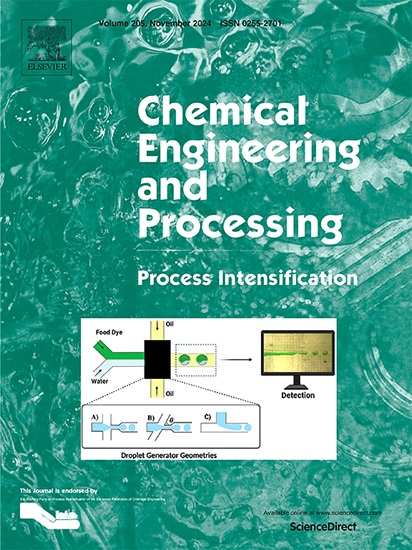以木屑木质素为可持续来源,超声辅助合成羧甲基木质素
IF 3.8
3区 工程技术
Q3 ENERGY & FUELS
Chemical Engineering and Processing - Process Intensification
Pub Date : 2025-02-08
DOI:10.1016/j.cep.2025.110211
引用次数: 0
摘要
可持续生物质为获得具有附加值的产品提供了潜力,大多数文献都集中在纤维素和半纤维素的使用上。目前的研究重点是利用木屑预处理后回收的木质素开发木质素基表面活性剂。考察了氯乙酸钠与木质素比(1:1-4:1 w/w)、反应温度(60-100℃)、反应时间(0.5-3 h)和NaOH浓度(1.5 M)等参数对常规方法合成效果的影响。在超声辅助下,通过改变超声功率(40 ~ 120 W)和占空比(30 ~ 70%)来确定最佳合成条件。在氯乙酸钠与木质素比为3:1、温度为90℃、时间为2 h的条件下,常规方法的临界胶束浓度(CMC)最小值为0.194;在温度为80℃、温度为1 h的优化条件下,超声法的临界胶束浓度最小值为0.057。对超声处理前后木质素及其羧甲基化产物进行了FTIR和NMR分析。结果表明,超声法可得到CMC值降低近70%的改进产物,同时大大减少了合成时间和氯乙酸钠的用量。本文章由计算机程序翻译,如有差异,请以英文原文为准。

Ultrasound-assisted synthesis of carboxy-methyl lignin from sawdust based lignin as a sustainable source
Sustainable biomass offers potential for obtaining products with added value with most literature focusing on use of cellulose and hemicellulose. The current study focuses on development of lignin-based surfactant utilizing the lignin recovered from pre-treatment of sawdust. Parameters such as sodium chloroacetate to lignin ratio (1:1–4:1 w/w), temperature (60–100° C), reaction time (0.5–3 h), and NaOH concentration (1.5 M) were varied to understand the effect on synthesis using conventional method. Additionally, ultrasonic power (40–120 W) and duty cycle (30–70 %) were varied in the ultrasound assisted approach to establish the best synthesis conditions. The lowest value of critical micellar concentration (CMC) with conventional method was 0.194 at 3:1 sodium chloroacetate to lignin ratio, 90° C and 2 h, while the lowest values of CMC with ultrasound was 0.057 at the optimised parameters of 2:1 sodium chloroacetate to lignin ratio, temperature of 80° C in just 1 h period. FTIR and NMR analysis was also performed on the extracted lignin and the carboxymethylation product with or without ultrasonic treatment. It was clearly demonstrated that improved product with almost 70 % lower CMC value could be obtained using ultrasound with significant reduction in the synthesis time and requirement of sodium chloroacetate as well.
求助全文
通过发布文献求助,成功后即可免费获取论文全文。
去求助
来源期刊
CiteScore
7.80
自引率
9.30%
发文量
408
审稿时长
49 days
期刊介绍:
Chemical Engineering and Processing: Process Intensification is intended for practicing researchers in industry and academia, working in the field of Process Engineering and related to the subject of Process Intensification.Articles published in the Journal demonstrate how novel discoveries, developments and theories in the field of Process Engineering and in particular Process Intensification may be used for analysis and design of innovative equipment and processing methods with substantially improved sustainability, efficiency and environmental performance.

 求助内容:
求助内容: 应助结果提醒方式:
应助结果提醒方式:


